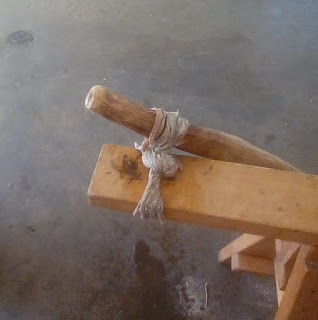Danger of Archery Practice and How to Overcome It
Every time your arm vibrates on a shot taken with a traditional bow, and it moves your your head, it will cause minute brain damage. When I used my 70lb longbow (or even a 45lb as well), I would have a headache after the practice. So i know that like a seasoned boxer or drunk, over time, the damage from the "punches" are building up.
Modern compound "bows" with horizontal limbs and the string stop bars centered on the riser result in little if any hand "shock" after a shot; therefore, these bows are not going to creating this problem. Horse bows or composite style bows are designed so the limbs reach brace at a more horizontal position than the long bow; in other words, the limbs tend to brace outward, moving away from the handle as opposed to pushing material, like the heavy limb tips, forward; this somewhat mimics the brace direction of moderne compound bows and thus helps to reduce hand shock.
To reduce hand shock further, use the following.
Executed perfectly, the arrow spur moves to reduce hand shock as there is an effortfull increase in the transfer of energy from the mechanics of the bow to shaft; but, performing it perfectly and consistently requires skill.
The following is the surest solution for many reasons - the straighter and more rigid you bow arm the harder the limbs will hit you as they return to brace; the shock will more directly reverberate through your arm and to your brain. The bow should always be slightly pushed; thus, if at the end of your practice you have a headache - you are doing archery WRONG and not pushing the arrow into flight. The kenetic energy must be efficiently transfered, Draw first to full - past the ear or wherever; with your bow arm now WELL bent, then push the energy of the limbs into the shaft and so into the target while adding the propper torque to ensure a clear exit of the arrow fletching.
If you are feeling hand shock, you are not doing enough of a push followthrough cast. Come to draw which will include the consideration of a appropriate follow through for that cast. Train to have you bow arm bent when you have come to a full draw. Your bow hand must work in tandem with the draw hand which is pulling to adiquate draw.
When the string is released, feel the movement of the arrow, apply the required outward touque, push the bow hand, slightly, efficently transferring all the propulsion provided by the limbs; doing this will transfer most of the power of the bracing limbs into the wood shaft. You do not feel much vibration in a perfectly executed arrow cast; the remainder of the thud will also be absorbed into the wrist, hand and shoulder. More control of the bow is achived when more practiced muscles are engaged. More focus to aiming can be invested when now unnecessary injury is avoided. Good archery takes practice to strengthen the right body and brain muscles. It requires time to understand the bows dynamic power and conduct it into a direct, controled motion, pushing the shaft into the correct flight.
If you are not strong enough to keep your bow arm bent at full draw - practice.
An additional suggestion, is to shoot a heavier arrow. The bow may be too strong and thus fast for the light arrows on the string.
Relax all your muscles except the ones needed to cast the arrow - relax your body and neck.
Given what has been said about follow through, another option is to use a short bow, like the plains Indians. The short bow allows you to reach a powerful draw and still have your bow arm well bent for a powerful follow through that will reach brace before your arm is extended. The result is bow that feels more like a slingshot.
Finaly, shoot with a heavier string - though this is still in expiramentation. This has the same effect as having a heavier arrow, it slows the shaft so you have more controle. Sinew strings are fantasic and tough - you can make a heavy and natural cord from this with ambient moisture being the only substantial concern.

